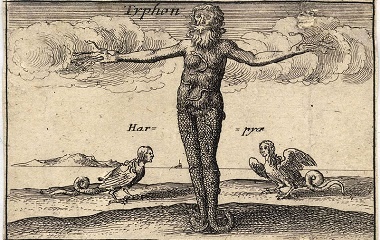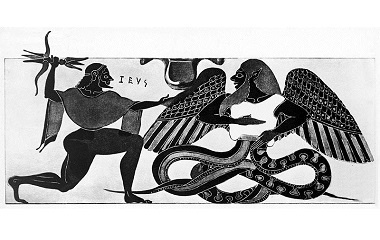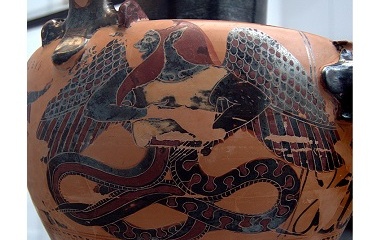Who is Typhon?
Huge, venomous, fire-breathing, and as mean as they come, Typhon is the most feared monster in all of Greek mythology. Soon after his birth, he challenged Zeus for the right to rule over all the gods — and he very nearly won!
Characteristics
Physical Description
The ancient Greek poets all painted a different picture of Typhon and for good reason. The only details they can agree on are that he was immeasurably large — “of such bulk that he out-topped all the mountains, and his head often brushed the stars” — and unimaginably hideous, worse than your most terrifying nightmare. Being immeasurable and unimaginable, Typhon was not an easy monster to describe!
Among other horrors, Typhon has been given: a hundred snake heads with eyes that shoot fire; leopard, lion, bull, boar, bear, dragon, and wolf heads; coils of snake tails below his waist; hundreds of arms and hands, with snakes for fingers; hundreds of wings spouting up all over his body; and one pair of huge dragon wings.
Over time, Greek artists merged and edited all of these poetic descriptions until they had reached a conventional look for Typhon. From the waist up, he was a wild giant with bulging muscles, a long, filthy beard, and shaggy hair. His nose grew out like a dog’s snout, his ears were pointed like a donkey, and his eyes flashed fire. Although he was usually drawn with just two of his hundreds of arms, his fingers were kept unnaturally long, suggesting serpents. A pair of feathery wings unfurled from his massive shoulders. Below the waist, Typhon had two serpent tails in the place of legs. His tails were usually drawn with vibrant red spots and a twisting, tangled look.
Personality
The Greek poets described Typhon as “terrible, outrageous, and lawless,” “fell and cruel,” “strong and tireless,” and “the greatest plague on men and gods.” Without a doubt, he was the biggest bully in Greek mythology—and there wasn’t a kind or merciful bone in his body.
For Typhon, destruction was a game and deformity was beautiful. He reduced villages to rubble for no reason, slaughtered men and attacked gods just because. He was attracted to dark places and monstrous characters—like his wife, Echidna—but even the places and people whom he liked couldn’t gain his loyalty. He spent his life on a solitary path of destruction.
Special Abilities
With so many monstrous parts packed into one body, Typhon never ran out of ways to attack. He could use his serpent heads or fingers to spit deadly venom at you. His dragon heads—or his own terrible eyes—could reign fire down upon you. All the while, his various other heads, from leopard to boar, would daze you with “his warcry, the cries of all wild beasts together” which was so loud that it echoed through the mountains and loosened boulders.
And don’t forget Typhon’s size. He was so large that his footsteps caused earthquakes. His voice was fiercer than thunder. He could use his mighty arms to break open mountains, hurling boulders and molten rock down on the villages below.
Typhon’s famous showdown with Zeus—the prize being no less than the Olympic throne—revealed the full extent of his abilities:
Eventually, Zeus got the upper hand, but even in death, Typhon was deadly:
When Zeus saw he had won, he threw Typhon into an endless pit, called Tartarus. Still, volcanic eruptions and winds that swept for hundreds of miles withering flowers and crashing ships, came from that pit where Typhon lay for hundreds of years.
Family
Parents
Many legends swirl around the birth of Typhon.
Some legends say that Gaia, the primordial earth-goddess, was angry when Zeus destroyed her children, the giants. She decided she would have another child, a giant of giants, to replace the children she had lost, but since Zeus had also defeated her husband, the titan Cronus, she needed a new lover. She turned to Tartarus, “the pit,” and with the help of Aphrodite, they were able to produce a child: Typhon.
Other legends claim that Hera had a fit of rage after she discovered yet another one of Zeus’s love-children. She declared that she would have a child without Zeus, since he had so many children without her, and that the child would be even mightier than Zeus himself. Some legends say that Gaia heard her cry and sympathized with her, so she made Hera pregnant with Typhon. Other legends say that Hera went to Cronus, and he gave her two stones covered in his own semen. Hera buried them, and after many months, one grew up as Typhon.
Children
For a bride, Typhon took Echidna, a monstrous snake-woman who lived in a cave and devoured men who happened to pass by. Of course, Echidna didn’t have much luck with devouring Typhon, so she accepted him as a mate instead and bore him many “fierce offspring,” including the Lynean Hydra, the Chimera, the Sphinx, Cerberus, the Gorgons, and Scylla. Together, Typhon and Echidna became as “the father and mother of all monsters.”
Cultural Representation
Origin
Typhon was first mentioned in Homer’s Iliad, which was written around the 8th century BCE, but he wasn’t fully fleshed out until Hesiod wrote his Theogony in the 7th century. Thereafter, countless Greek and Roman poets tackled this great monster; Pindar, Virgil, Ovid, Nonnus, and Seneca all contributed to his legend.
But it’s possible that Typhon has an event older ancestor. The Greeks themselves pointed out that there was a connection between their monstrous Typhon and the Egyptian god Set, who also sparked terrible battles when he tried to seize control from the supreme god.
Modern Appearances
During Greek times, Typhon was connected with all kinds of natural disasters, from droughts to tsunamis to wildfires and volcanic eruptions. Appropriately, his name lives on in today’s culture as dreaded natural disaster: the typhoon.
Typhon has also showed up in many modernized versions of Greek mythology, including Clash of the Titans and Percy Jackson.
Typhon






No comments:
Post a Comment